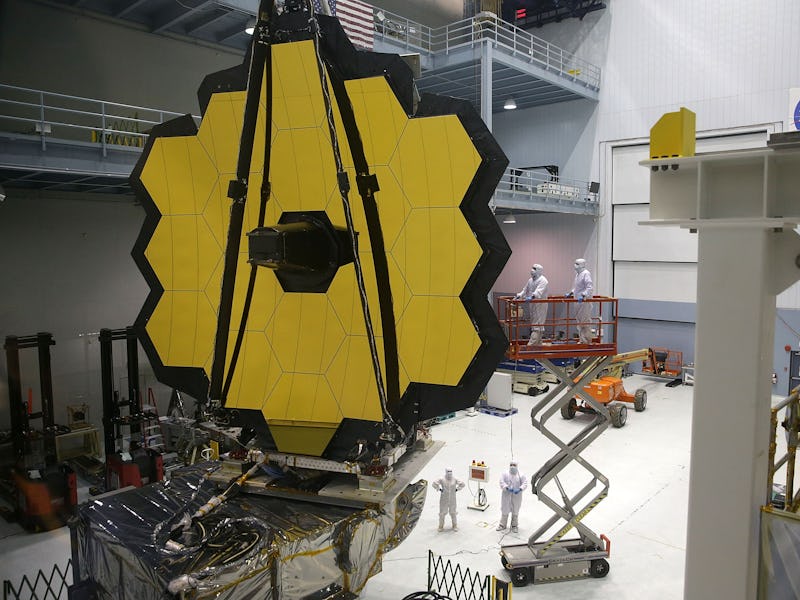The Webb Telescope could unlock the search for life by studying inhospitable hellworlds
NASA recently explained why the JWST is honing in on “Hot Jupiter” exoplanets.

Now that it has begun science operations, some of the top targets for the James Webb Space Telescope will be exoplanets. The telescope can identify and examine planets outside our solar system, and can even look into their atmospheres to see what they are composed of. That will give us more information than ever before on the diversity of planet types out there.
If you look at data on exoplanets that have been studied in the past and are set to be studied in the future, you’ll notice that many of them are a type called a hot Jupiter. Very different from rocky planets like Earth, Mars, or Venus, hot Jupiters are gas giants which orbit very close to their host stars. With a year on a hot Jupiter lasting just a few days or even just a few hours, they are close enough to their stars to experience very high temperatures of thousands of degrees Celcius. And they vary in mass from a little lighter than Jupiter to over ten times its mass.
NASA depiction of a Hot Jupiter exoplanet.
As strange as these planets sound — and as different as they are from anything in our solar system – studying them could be crucial for learning about how planetary systems form. Scientists still aren’t sure how hot Jupiters come to be, as they seem to orbit too close to their stars to have formed there. Perhaps they formed further out and then got pulled into a closer orbit, or perhaps tidal forces affected their orbits. We don’t know for sure.
Another reason to study these planets is that they tend to be puffy, as they have the mass of a planet but can be up to the size of a star. If a planet has a puffy atmosphere it’s easier to get data about that atmosphere using spectroscopy, in which light coming from the star passes through the atmosphere and is analyzed to see what that atmosphere is made of.
One such puffy atmosphered hot Jupiter is WASP-121b, a monster planet with a temperature of over 2000 degrees celsius. “It’s got a very inflated, puffy atmosphere. And it’s also got a very clear atmosphere because it’s too hot for clouds and hazes to form, which makes it a very tempting target for transmission spectroscopy because there’s a lot of atmosphere for the parent star’s light to shine through,” explained Steph Merritt of Queen’s University Belfast who studied the planet using a method called Doppler spectroscopy, in a talk at the National Astronomy Meeting 2022.
Artist's illustration of the “football-shaped” WASP-121.
It’s not easy to study the atmosphere of a planet millions of miles away though. Previous work on exoplanet atmospheres has been done by both ground-based telescopes and by Hubble, but there are limits to how much these tools can tell us. Hubble has been used to study the atmosphere of hot Jupiter WASP-17b, for example, but the observations only caught part of the transit (the period when the planets pass in front of the star, making spectroscopy possible).
This makes data analysis difficult, as there is a lot of uncertainty about what specific elements make up WASP-17b’s atmosphere. “All we can really say for certain about WASP-17b is that the current data shows a confident direction of H2O and a tentative hint of CO2,” said Lili Alderson of the University of Bristol, who worked on a reanalysis of data on the planet, at the same meeting.
WASP-17b will be one of the first targets that James Webb studies in its first year, which will help to reveal more about its atmosphere by gathering more data in the infrared range, in addition to the optical data gathered by Hubble. “We need the combination of high-quality optical and infrared data to properly understand the atmospheres of these planets,” Alderson said.
From top left to lower left: WASP-12b, WASP-6b, WASP-31b, WASP-39b, HD 189733b, HAT-P-12b, WASP-17b, WASP-19b, HAT-P-1b and HD 209458b.
An example of the oddity of hot Jupiters is that many of them show a phenomenon called inverted atmospheres, in which temperatures in the upper atmosphere increase with altitude. You’d expect that atmospheres would be cooler as you get higher up — unless you have a special situation like the Earth’s ozone layer. The current theory is that the metallic elements found in hot Jupiter atmospheres, like titanium oxide, vanadium oxide, and iron hydride, which absorb light from the star and warm the atmosphere, in a similar way to our ozone layer.
As much as astronomers have learned about hot Jupiters so far, there’s still a lot more to learn with James Webb. If we can find out how these odd planets formed, we’ll learn more about the formation of other systems, including our own solar system. However, even with this additional data, it might not be enough to fully understand this strange and alien world.
“Planets are really complicated!” Alderson said. “We can’t always make bold and exciting conclusions with one simple set of data.”
This article was originally published on